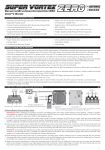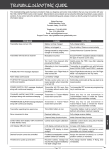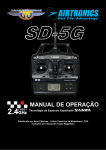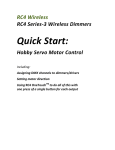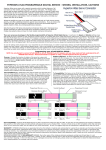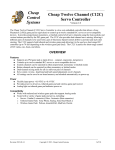Download Century Helicopter Products Robinson22HP Instruction manual
Transcript
Telebee Heading Lock Piezo Gyro Instruction Manual Warning, if any radio system is used other than those listed make sure same polarity is maintained and double check your connections, otherwise you will Rudder Servo damage the Aerotech (Fast Speed) gyro. Reverse Switch Rudder Servo In Rudder Channel on Rx Gain Red Lead CN2238 For Helicopter Use Mfg. test port (not for end user) Please read instructions completely before operation. Features: Heading lock & rate mode selectable - Remote & manual gain settings Solid state with no moving parts for nearly unlimited use - Small and lightweight sensor with amplifier module - Temperature differential compensated circuitry - Offset drift cancellation during initialization phase Compatible with JR, Futaba, Hitec and Airtronics “Z” radio systems. Specifications: Dimensions: 1.28”L x 1.28”W (1.50” at Base) x 1.10“H - Weight: 24.5 g (0.69 oz) sensor & 15.5 g (0.44 oz) amp - Power Supply: 4.8 -7.2 Volts Current Consumption: 33 ma - Operating Temp: 23° - 130°F. High Speed Servo Selection: A quality high speed ball bearing servo is required for use with the Heading Lock mode. Due to the extremely fast response in the Heading Lock mode, regular servos will overheat and eventually fail. The actual torque of the servo is not as important as the speed which should fall between 0.16 ~ 0.06 seconds per 60 degrees rotation. Helicopter Tail Rotor System: The maximum holding power (the actual gain setting that will dampen the largest input without the tail oscillating) is directly related to how rigidly the tail assembly is attached to the helicopter. Loose tail support struts, tail boom fixture bolts or slipping tail drive shaft/belt will all contribute to reducing the holding power on the tail. A smooth rudder tail linkage is the key factor to check and maintain to keep a reliable, strong tail for the helicopter. Supplied Connectors: Two harnesses are provide to connect the amplifier to the receiver, these are a direct fit for Futaba. White = Signal Red = Pos + Black Red White Black = Neg - Top Solid top surface of connector to be bevelled. To p JR and Airtronics “z” require the (rx) plugs to have the top corners bevelled as shown. Using a small flat file or careful scraping with a knife remove enough material to easily insert into the receiver. Radio Connector Type JR red to red black to brown white to orange Futaba red to red black to black white to white Hitec red to red black to black white to yellow Airtronics Z red to red black to black white to blue Gear/Aux Channel (Switch) on Rx Receiver Connect to Gyro If the red light flashes on the gyro, no signal is being received, turn off. Turn on the transmitter and turn the gyro back on. Also, if the gyro needs to be reversed, switch off the gyro, move the reverse switch and turn the gyro back on. Transmitter Settings: Servo Reverse Travel* (ATV or EPA) Revo Mix H L Up Down Sub Trim / Mechanical Trim Rudd N 100% 100% 0% 0% 0 Gear/Aux N 100% 100% 0 *Settings based on a JR 6 channel radio, note the initial Rudder (ATV or EPA) is set at 100%, the control ball location (distance from servo center to the hole on the servo horn) needs to be set such that as the pitch plate travels through the entire movement range no mechanical linkage binding occurs. If necessary move the control ball one hole inwards on the horn. Mounting the gyro sensor: 1. Each helicopter kit recommends a location for mounting the gyro sensor, usually close to the main shaft. Keep away from the engine and exhaust system due to changes in temperature affecting the gyro. Mount the amplifier in the servo tray along with the receiver and battery pack. The surface that the sensor will be mounted need to be prepared with a mild cleaner that will not degrade the surface that the foam tape with adhere to (rubbing alcohol is recommended.) Using two pieces of foam tape, double up and attach to the bottom of the sensor base. Then attach the sensor with the adjustable pots facing an open direction for access. Make sure the sensor does not contact the helicopter frame or other radio components or wiring. Step 1 Turning the Gyro On for the First Time: Disconnect the rudder pushrod from the servo horn. After connecting the rudder servo to the gyro and both the Rudder lead and the Aux/Gear lead to the receiver, switch the gyro on and wait 10 seconds for the gyro to initialize (the rudder servo with twitch to indicate it is ready). The moment the servo twitches watch the rudder servo, the servo will stay in one position (rate mode) or will start moving in one direction (heading lock mode). If in heading lock mode, toggle the Gear switch to rate mode for now. It is completely normal for the servo to move all the way to one side and stop while in heading lock mode, it is extremely important that the rudder pushrod is not connected. The servo will stop based on the Rudder ATV/EPA setting, currently at 100%. Turn off the gyro for now. Once more review your radio and ensure that Revolution Mixing (revo) is inhibited or the Up and Down settings are set to zero. Reset your sub trims, trim tabs to neutral and make sure the rudder servo does not move (without gyro connected) when switching flight modes. Step 2 Setting the Heading Lock Neutral: Toggle the Gear / Aux switch into heading lock mode, using the electronic sub trim for the rudder channel, add left or right trim to minimize the servo from moving. This may require you to switch back to rate mode once to reset the servo. Remove the servo horn and reset the horn to 900 or the helicopter’s neutral position for the rudder servo. Now the rudder trim is only used in the heading lock mode to keep the servo in neutral. Occasionally the neutral needs to be reset with changes in temperature. 90° pushrod Always wait 10-15 minutes before flying for the helicopter at the beginning of the day to stabilize with the outside 12-16mm temperature. Step 3 Rudder Servo Setup: 1. Disconnect the tail pushrod from the rudder servo and check that the pushrod is smooth and requires only a gentle force to move from one endpoint to another through the entire range of movement. Make necessary changes if needed. 2. Following the instructions provided with the helicopter set the rudder pushrod length so the pitch slider is centered within it’s movement range and has the proper 5° of tail pitch to hold the helicopter straight in a hover. 3. Turn on the gyro and wait the 10 seconds while it initializes. Switch to rate mode so the servo returns to center. Move the rudder stick completely to the left side and select the hole on the servo horn for the control ball or “z” bend that allows complete travel without binding. Now move to the right side to check for binding. Only adjust the position of the control ball to achieve complete throw (generally between 12-16mm from the center of the servo), leave the Rudder ATV/EPA at 100% on both sides, this permits perfect mechanical setup. Do not change the rudder trim tabs as these are assigned to the Heading Lock mode. Continue until tail holds straight in a hover. Nose turns left increase* tail pitch by shortening pushrod Nose turns right decrease* tail pitch by lengthening pushrod *Settings are based on helicopters with the tail rotor assembly mounted on the right hand side of the helicopter when viewed from behind. Finishing Setup: At this stage the helicopter will be setup for both heading lock and rate mode flying. Remember, if any changes are made to the heading lock trim or the reverse switch on the gyro, switch the gyro off and let the gyro re-initialize when turned back on. Troubleshooting Gyro Gain: 1. If hunting occurs at less than 65% while hovering then: a) check for excessive free play in the rudder pushrod b) increase the foam tape thickness below the gyro c) shorten the tail rotor blades 2. If no hunting occurs at 100% while hovering then: a) lengthen the tail rotor blades. Basic Transmitter Configuration: The following chart lists how the gyro mode settings corresponding to the switch position on the radio. To change the Heading Lock / Rate position on the assigned switch change the direction of the Servo Reverse switch for the Gear / Aux channel. JR / Airtronics Z Heading Lock Rate Gyro Direction Switch Front Back N Futaba / Hitec Heading Lock Rate Gyro Direction Switch Back Front R Step 4 Gear Channel ATV (Gain Settings): The Gear ATV (travel volume) controls the both gain settings for the gyro. Initially set both values to 50% as a starting point. Rudder Channel ATV (Pirouette Rate & Servo Limits): Gear ATV / EPA Up Down 100% 100% 75% 75% 50% 50% Gain Setting 100 75 start at 50 Step 5 First Flight Heading Lock Mode: Start with the switch in Heading Lock mode. As the throttle stick is increased the rudder servo will slowly move the pitch plate to one side, while the helicopter is still on the ground glance at the tail pitch plate and add a small rudder input to re-center the pitch plate before lift off. Bring the helicopter to a hover and keep increasing the Heading Lock Gain (Gear ATV) until the tail starts to oscillate (hunt). At this point reduce Gain setting slightly (510%). Bring the helicopter into slow forward flight. If hunting occurs, reduce the gain setting slightly. Continue until fast forward flight is possible without the tail hunting, record this value. If hunting suddenly occurs later, thoroughly check the helicopter for worn parts in the tail pushrod system. Step 6 First Flight Rate Mode: Start with the switch in Rate mode and an initial gain setting of 50% on the Gear channel (ATV). Beginners should be using training gear at this step. Slowly increase throttle stick until the helicopter is still on the ground, just prior to lift off. Increase the throttle slightly and observe the direction the helicopter starts to rotate and reduce the throttle to an idle. All adjustments from here are made to the length of the rudder pushrod only. Rudder ATV / EPA Left Right Servo Throw Pirouette Speed 0 0 100% 100% +40 / -40 Fastest 75% 75% +350 / -350 Medium 50% 50% +300 / -300 Slow The Rudder ATV (travel volume) controls the servo endpoints which ultimately controls the maximum pirouette speed that the helicopter will achieve. After flight testing, these values can be modified to get the desired control response from the tail. Warranty Coverage Your new equipment is warranted to the original purchaser against manufacturer defects in material and workmanship for 90 days from the date of purchase. The warranty is limited to the original purchaser and is not transferable. This warranty does not apply to any unit which has been improperly installed, mishandled, abused or damaged in a crash, or to any unit which has been opened, repaired or altered by any unauthorized agencies. Under no circumstances will the buyer be entitled to consequential or incidental damages. Do not subject your gyro to extreme temperatures, humidity or moisture or in direct sunlight for long periods of time. Due to the delicate nature of the electronic components, the impact of dropping the gyro to the floor can damage the unit. If the gyro requires service and is within the warranty period, call for a return authorization # and include a copy of the original receipt. Return your gyro unit only in the original box with foam packaging. Package the unit in a sturdy container and include full return address and description of damage. Send the parcel insured and postage prepaid, please allow 8-12 weeks for service. Non-warranty repairs- You will be advised on the repair cost, please allow 8-12 weeks for service. Century Helicopter Products: 523 Sinclair Frontage Road, Milpitas, CA 95035 USA



